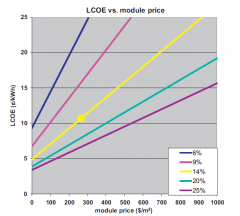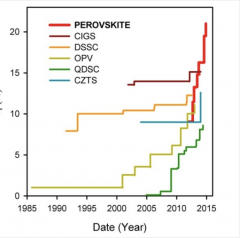Thrust 1: PHOTOVOLTAICS
Focus of the thrust:
- Development of new concepts and materials for photovoltaic devices
- Emphasis on low cost solution compatible processes for deposition
- Encompasses fundamental studies as well as realisation of practical energy conversion devices
- Material systems studied include chalcogenides, halide perovskites, 2D materials

Figure 1: In order to hit specific electricity cost targets (LCOE), it is necessary to not only reduce costs, but to target high efficiencies. (Ex-tracted from Renewable and Sustainable Energy Reviews 15(2011) 4248-4254.
Although solar power is the world’s most abundant source of energy, the difficulty has always been converting solar energy in an efficient and cost-effective manner. For photovoltaic energy to become competitive with fossil fuels and to capture a significant share of the electricity market, it is necessary to reduce the total cost of solar energy. This can be achieved by either reducing the cost of photovoltaic cells or by increasing their power conversion efficiencies. The photovoltaic market is currently dominated by crystalline Si solar cells with lab scale efficiencies close to 25%. Alternative “third generation” technologies such as organic photovoltaics (OPVs), dye sensitized solar cells (DSCs) and quantum dot solar cells (QDSCs), which are fabricated through solution based processes such as blade coating, screen printing and spraying, promise low cost solar power while allowing the utilization of unconventional substrates.
Even though the utilization of low temperature processes reduces the energetic costs and the energy payback time, the power conversion efficiencies (PCEs) of these solar cells still lag significantly behind conventional solar cells. The levelized cost of energy (LCOE), (Fig 1), which allows for the comparison of various electricity generation sources, depends critically on the efficiency of the solar cells produced. A more efficient module yields more power per unit area. A significant fraction of a solar cell cost scales proportional to the installation area, including the cost of the glass, inverter costs and installation costs, among others. A more efficient solar cell allows for a reduction in all the costs associated with installation, while requiring much lower numbers of solar panels to be installed. Thus the PCE is a primary driver of cost for solar cells.

Figure 2: The rapid growth in efficiencies in haide perovskite solar cells have made it the most efficient solar cell technology.
Organic–inorganic halide perovskite solar cells have been the most significant development in the field of photovoltaics in the present decade, and are the best bet at satisfying the need for high efficiencies while allowing for low cost solution based manufacturing. Since the first reports of stable solid state solar cells based on the CH3NH3PbI3 perovskite in mid-2012, the PCEs of the solar cells have already exceeded 20%, leapfrogging every other solution-processed solar cell technology, (Fig 2). Our work aims the improvement of CH3NH3PbI3 efficiency and stability through a deep understanding of the fundamental properties of this material, as well as the development of new perovskite absorbers (lead-free and multidimensional) and device concepts (tandem). In the following, we summary results of four tasks in this Thrust aimed at solar cells with higher efficiency, stability and scalability.Even though the utilization of low temperature processes reduces the energetic costs and the energy payback time, the power conversion efficiencies (PCEs) of these solar cells still lag significantly behind conventional solar cells. The levelized cost of energy (LCOE), (Fig 1), which allows for the comparison of various electricity generation sources, depends critically on the efficiency of the solar cells produced. A more efficient module yields more power per unit area. A significant fraction of a solar cell cost scales proportional to the installation area, including the cost of the glass, inverter costs and installation costs, among others. A more efficient solar cell allows for a reduction in all the costs associated with installation, while requiring much lower numbers of solar panels to be installed. Thus the PCE is a primary driver of cost for solar cells.